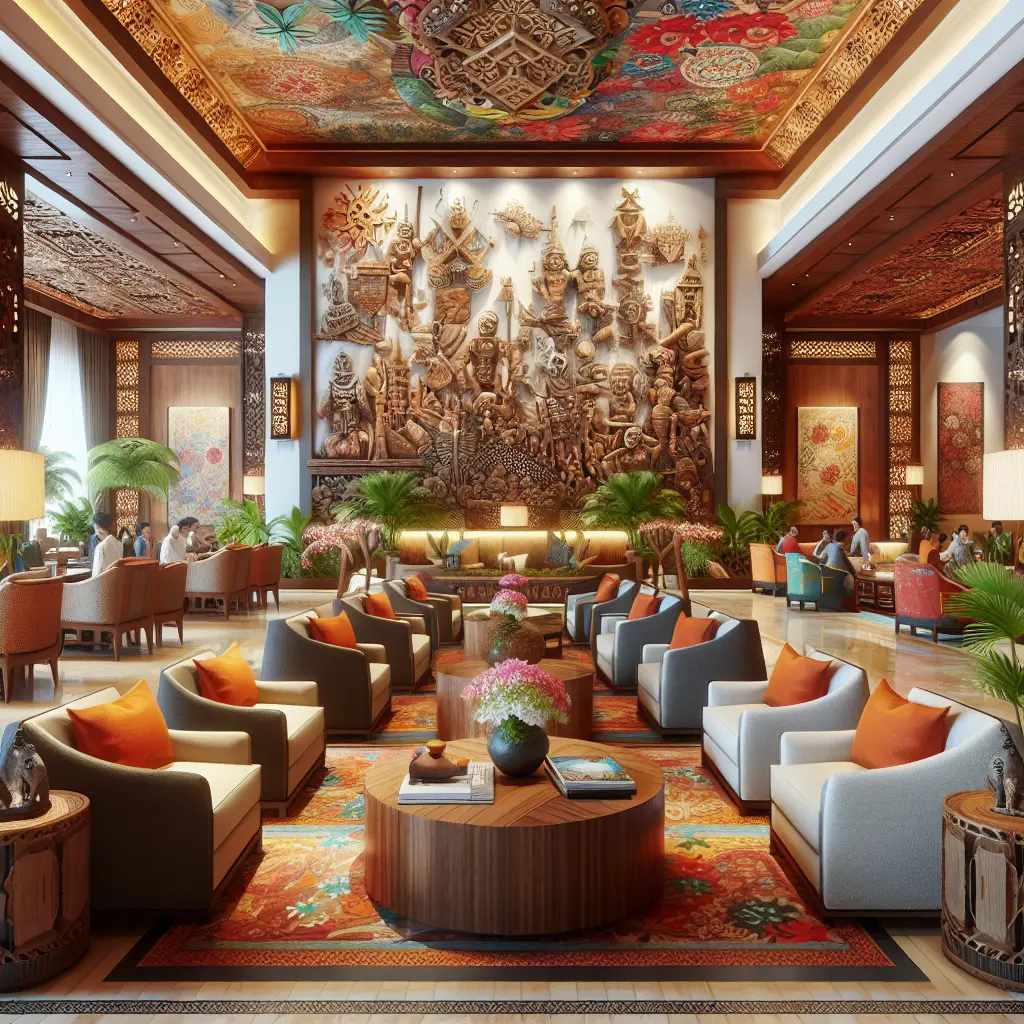In the ever-evolving world of hospitality, hotel interior design stands as a crucial factor in shaping guest experiences and brand identity. A fascinating trend gaining momentum is the infusion of local culture into hotel interiors, which not only enhances aesthetic appeal but also delivers tangible financial benefits. This approach, where hotel design is influenced by culture, offers a unique blend of authenticity and innovation, appealing to discerning travelers seeking immersive experiences. By understanding the cultural impact on hotel interiors, hoteliers can create spaces that resonate with guests on a deeper level, driving loyalty and repeat visits.
The economic advantages of culturally inspired hotel interior trends are becoming increasingly apparent. By leveraging local culture in hotel interior design, establishments can maximize revenue through cultural design elements that differentiate them from generic accommodations. This strategy is not only cost-effective but also yields a significant return on investment. From luxury establishments to budget-friendly options, incorporating cultural interior design can enhance guest experience while simultaneously boosting hotel profitability.
Moreover, culturally designed hotels offer an array of economic benefits, from increased occupancy rates to enhanced guest satisfaction scores. As travelers continue to seek authentic and enriching stays, the local culture's influence on hotel profitability cannot be understated. The intersection of hotel design trends with cultural influence signifies a shift towards more personalized and meaningful travel experiences.
As we explore the nuanced relationship between culture and design, we'll uncover how this trend transforms not only the aesthetic but also the economic landscape of hospitality. Join us as we delve deeper into the financial benefits of cultural design in hotels and discover how these culturally inspired spaces are redefining modern luxury.
The Impact of Local Culture on Hotel Interior Design
Embracing Cultural Heritage
The dynamic nature of hotel interior design is significantly influenced by the cultural nuances of the region in which a hotel is situated. This integration of local culture not only enhances the aesthetic appeal but also serves as a powerful tool for differentiation in the competitive hospitality industry. By aligning hotel design with local culture, establishments can create immersive environments that attract discerning travelers seeking authentic experiences. This trend is reflected in various recent developments and examples worldwide.
Incorporating local culture into hotel interior design goes beyond mere decoration; it involves a deep understanding and respect for the region's history, traditions, and artistic expressions. One striking example is the Radisson BLU Hotel Kaş in Turkey, designed by Öznur Çaglayan Architectural Design Studio. The hotel merges Mediterranean tradition with modern luxury, creating a space that resonates with both locals and international visitors. By weaving elements like traditional Turkish motifs and local materials into the design, the hotel provides guests with an experience that is both luxurious and culturally enriched.
Financial Benefits of Cultural Design
The financial benefits of incorporating local culture into hotel design are substantial. Hotels that embrace culturally inspired interiors often see increased occupancy rates and enhanced guest satisfaction scores, leading to higher profitability. This approach allows hotels to command premium pricing due to their unique offerings, ultimately maximizing revenue through cultural design.
For instance, the Babanango Game Reserve in Zululand, South Africa, showcases how cultural and environmental renewal can enhance guest experiences while boosting financial returns. According to Hospitality Net, the reserve's transformation from cattle farming to a conservation-focused luxury destination has attracted eco-conscious travelers, increasing both occupancy and guest loyalty. The use of local cultural elements in design has been integral to this success, reinforcing the reserve's commitment to authentic experiences.
Luxury Meets Culture
Luxury hotels are increasingly turning to cultural interior design to differentiate themselves in the market. The integration of local culture into luxury hotel interiors not only enhances the guest experience but also aligns with sustainable practices and ethical tourism. The PARKROYAL COLLECTION Marina Bay in Singapore exemplifies this trend. As reported by Antara News, this hotel has achieved multiple sustainability certifications while maintaining its luxurious appeal by incorporating local design elements and sustainable materials.
This strategic alignment of luxury and culture demonstrates a significant return on investment for hotels that choose to incorporate cultural elements into their design. It enables them to attract high-spending travelers who value both comfort and cultural authenticity.
Cost-Effective Cultural Design for Budget-Friendly Hotels
The benefits of culturally inspired design are not limited to luxury establishments. Budget-friendly hotels can also leverage local culture to create distinctive and attractive spaces without incurring significant costs. By focusing on key cultural elements such as art, textiles, and furnishings that reflect the local heritage, these hotels can enhance their appeal while maintaining cost-effectiveness.
A notable example is the approach taken by several designers recognized at the Dezeen Awards China 2024. Emerging talents like Line+ Studio and Yatofu have demonstrated how thoughtful design incorporating local cultural elements can elevate the guest experience without excessive expenditure. These projects highlight the potential for budget-friendly hotels to benefit economically from culturally inspired interiors.
Enhancing Guest Experience Through Cultural Design
Integrating local culture into hotel interiors significantly enhances the guest experience by providing a sense of place and connection to the destination. This approach goes beyond aesthetics, fostering a deeper emotional engagement with guests who appreciate authenticity and storytelling through design.
Hotels that succeed in this area often utilize local artisans and craftsmen to create bespoke elements that reflect regional heritage. This not only supports the local economy but also ensures that each piece has a story, adding layers of meaning to the guest experience.
Local Culture Influence on Hotel Profitability
The influence of local culture on hotel profitability is profound. By creating spaces that resonate with the cultural identity of a location, hotels can build brand loyalty and encourage repeat visits. The emotional connection fostered through culturally rich design often leads to positive word-of-mouth marketing and increased bookings.
A relevant discussion in Construction Physics explores how architectural trends have evolved, emphasizing functionality over ornamental excess. In contrast, culturally inspired hotel interiors strike a balance between aesthetic appeal and functionality, proving that thoughtful design can be both beautiful and economically advantageous.
In conclusion, as travelers continue to seek meaningful and authentic experiences, the trend of integrating local culture into hotel interior design is set to grow. By embracing this approach, hotels can not only enhance guest satisfaction but also achieve significant economic benefits, ensuring a competitive edge in the ever-evolving hospitality landscape.
Final Thoughts or Conclusion
Incorporating local culture into hotel interior design is a powerful strategy that offers multifaceted benefits, from enhancing guest experiences to boosting profitability. As discussed, the critical aspects of culturally inspired design include:
- Embracing Cultural Heritage: Hotels like the Radisson BLU Hotel Kaş in Turkey effectively merge local traditions with modern luxury, offering guests authentic and enriched experiences. - Financial Benefits: Integrating cultural elements can lead to increased occupancy rates and premium pricing, as demonstrated by destinations like Babanango Game Reserve in South Africa. - Luxury Meets Culture: Luxury hotels are leveraging cultural design to distinguish themselves and achieve sustainability certifications, exemplified by PARKROYAL COLLECTION Marina Bay in Singapore. - Cost-Effective Solutions for Budget Hotels: Even budget-friendly establishments can benefit by thoughtfully incorporating local art and textiles, as shown by innovative designers recognized at the Dezeen Awards China 2024. - Enhancing Guest Experience: Utilizing local artisans to create bespoke designs fosters deeper emotional connections with guests, enhancing overall satisfaction and loyalty.The influence of local culture on hotel profitability is substantial, with culturally rich interiors encouraging repeat visits and positive word-of-mouth marketing. As travelers increasingly seek authentic experiences, the trend of integrating local culture into hotel design is poised for growth. Hotels that embrace this approach not only enhance guest satisfaction but also secure a competitive edge in the hospitality industry.
Sign Off
As we continue exploring the vibrant intersection of culture and design, we invite you to share your thoughts or experiences. How has local culture influenced your travel choices or enhanced your stay? Let's connect and continue the conversation on this fascinating journey.






Leave a Comment